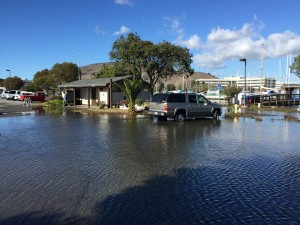South San Francisco, CA December 13, 2015 Submitted by San Mateo County
Program Overview
The County of San Mateo has initiated a sea level rise vulnerability assessment as part of a long-term resilience strategy to ensure our communities, ecosystems, and economy are prepared for climate change. This joint project is being completed in partnership with the California State Coastal Conservancy.
ARCADIS will conduct a technical study to compile a list of assets that have the potential to be impacted by inundation. A more detailed evaluation of vulnerability will be completed for 30 representative assets in the County. In addition, this effort will include a focus on nature-based solutions and reducing impacts to underserved communities. The final report will include recommended next steps and conceptual design of adaptation options for key assets in San Mateo County.
Stakeholder Engagement
The project will be informed by a Technical Working Group, Policy Advisory Committee, Community Task Force, and by community input through public events and workshops.
The Technical Working Group (TWG) is comprised of individuals with a working knowledge and familiarity with the physical location, surrounding environment, proximity to sea level rise associated risks, and the operation of key assets in San Mateo County.
The Policy Advisory Committee (PAC) is comprised of high level city officials and individuals with knowledge of formation or implementation of regulations, policies/programs related to hazard mitigation, disaster preparedness, public health, transportation, real estate development, and natural resource management. PAC member will provide high level guidance on the project approach and work products.
The Community Task Force (CTF) consists of community group representatives who are actively involved in the community and are able to help plan and conduct outreach efforts to raise public awareness on sea level rise. The CTF will meet on a regular basis for the duration of the Assessment, October 2015 to June 2016. The Community Task Force will advise the Project Management Team on outreach efforts, such as recommending groups to connect with, events to attend, and methods that would resonate with the local community.
Specifically, the Task Force will provide guidance on public engagement and the planning of 2 public workshops.
Methodology
The vulnerability assessment will be conducted using existing sea level rise modeling completed by United States Geological Survey (USGS) as part of the Our Coast Our Future (OCOF) tool. ARCADIS will use a range of scenarios to evaluate how different amounts of sea level rise, combined with the 1% annual chance storm, will affect the County. Using the results of the sea level rise mapping, ARCADIS, in coordination with the Technical Working Group, will evaluate which assets are at risk over the near and long term.
Develop Approach
The Vulnerability Assessment began with a Kick-Off Meeting held on June 5th, 2015. This initial approach involves gaining stakeholder interest, identification of project goals, and creating a detailed step by step Methodology on how goals will be achieved.
Data Gathering + Asset Categorization
Data gathering includes compiling GIS data and other information on assets in the project area, including data on habitat types, roads, buildings, energy, and socially vulnerable communities. Once data has been gathered, assets that could be exposed to inundation will be objectively categorized.
Inundation Exposure Analysis
ARCADIS will develop maps identifying assets that are at exposed to the project’s inundation scenarios. With help from the Technical Working Group, ARCADIS will create a list of these assets.
Vulnerability + Risk Analysis
In coordination with the TWG, the project management team will select 30 representative assets for further study based on the list of assets. The 30 assets will be representative across cities and asset types in San Mateo County. For example, the 30 assets will likely include: hospitals; community centers; energy infrastructure; wastewater treatment plants; transportation infrastructure; beaches; and wetlands.
Adaptation Planning
The final step will identify conceptual adaptation measures to reduce risk to San Mateo County and its assets. In addition, two or three artist renderings of regional adaptation measures will be prepared as a visual representation of how San Mateo County could look under the suggested adaptation measures.
Get Involved
Learn more at http://seachangesmc.com/ or contact Hilary Papendick, Climate Resiliency Specialist, San Mateo County at hpapendick@smcgov.org, or 650-363-4194 to find out more about upcoming events and opportunities for engagement.
###
Flooding at Oyster Point Marina is a concern as the area is built upon the old landfill; settlement and leeching of toxic material are both issues being investigated.

Tenant Restroom & Parking Area
King Tide flooding at Oyster Point Marina—Wed., Nov. 25, 2015
Photo: S Brennan

Bay Trail
King Tide flooding at Oyster Point Marina—Wed., Nov. 25, 2015
Photo: S Brennan